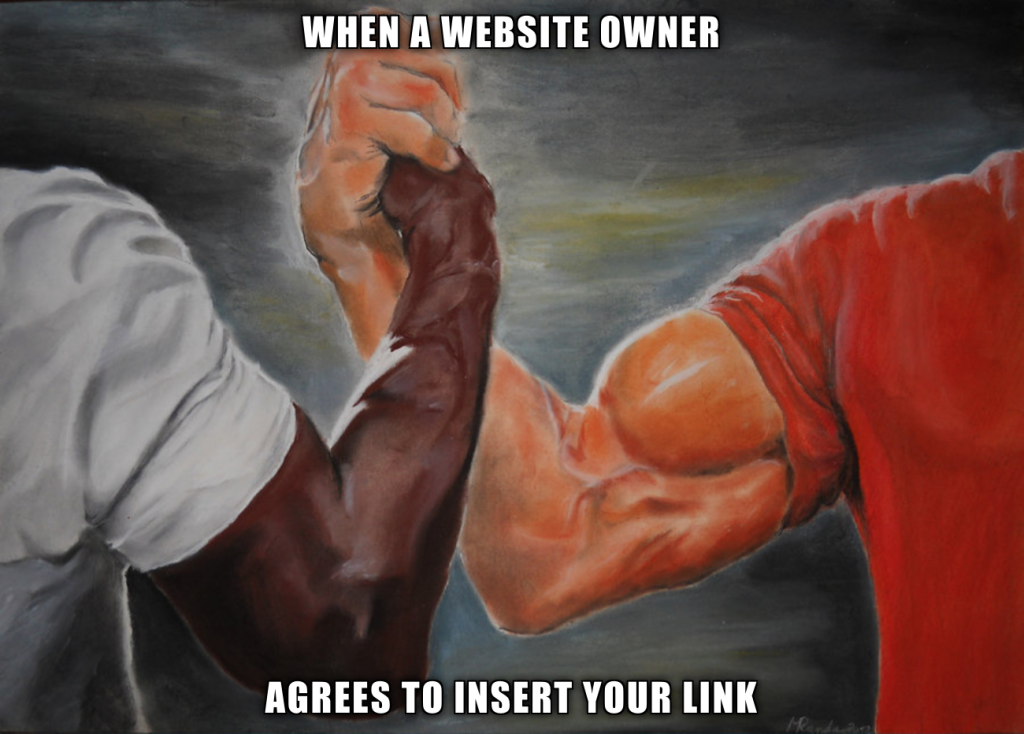You’ve probably heard that backlinks and link building are crucial to your SEO strategy.
But what exactly are backlinks, and why do they carry so much weight?
In this comprehensive guide, we’ll break down their importance, how they work, and how you can build links strategically to boost your SEO performance.
By the end of this article, you’ll have a clear roadmap for leveraging quality links as part of your content marketing efforts.

What are backlinks?
A backlink is a link from one website to another.
The website linking to the destination is often called a referring domain.
Think of a backlink as a vote of confidence from one site to another.
The more votes you get, the more trust you build, and the higher you’ll rank in search engine results.
But not all backlinks are beneficial.
Building links from spammy or irrelevant sites can harm your backlink profile (more on this later).
Why do backlinks matter?
Google and other search engines use complex algorithms to rank websites, and backlinks are one of the key factors in this equation.
They help search engines determine the authority of your website in your particular niche.
For example, if you run a fitness blog and a well-known health magazine links to one of your articles, that’s a strong indicator your content is credible and valuable in the health and fitness realm.
It’s not just about quantity, though. The quality of your backlinks is equally, if not more, important.
A single link from a high-authority website can be more impactful than dozens of links from low-quality sites.

Internal vs. external links
Internal links are those that point to different pages within your own website. They’re crucial for several reasons:
- Ease of navigation: Well-placed internal links make it easier for visitors to find what they’re looking for, improving user experience.
- SEO benefits: Internal links help search engines understand the structure and content of your website, which can lead to better rankings.
- Page authority: By linking less popular pages to more popular ones within your site, you can distribute page authority and improve the SEO of lesser-known content.
An external link, on the other hand, is a link from another website pointing to your site.
These are harder to get but offer significant benefits:
- Increased visibility: A backlink from a popular site can drive a lot of traffic your way.
- SEO boost: High-quality external backlinks can significantly improve your search engine rankings.
- Credibility: Backlinks from authoritative sites enhance your site’s credibility, making it more likely that people will trust and engage with your content.

Factors that determine link quality
We know that not all backlinks are created equal, so let’s dig into what makes a backlink valuable:
- Global popularity: The more popular a website is, the more valuable its backlinks will be. If a well-known site like Wikipedia links to you, that’s a big win because of its broad audience and high trust level.
- Local popularity: This refers to the concept that sites within a specific industry or niche tend to link to the same pages. If your website is about gardening, for example, backlinks from other gardening sites will carry more weight than those from unrelated sites.
- Anchor text: This is the clickable text in a hyperlink. Search engines use anchor text as a clue for what the linked page is about. If someone links to your gardening site with the anchor text “best gardening tips,” that’s a good indicator for search engines that your page is a valuable resource on gardening.
- Link context: The content surrounding the link also matters. A backlink will have more value if it’s embedded in content that is relevant to your website. For instance, a link to your gardening site will be more valuable if it’s in an article about gardening techniques rather than a piece on automotive repair.
- Authority of the linking site: A backlink from a reputable, authoritative site will always be more valuable than one from a lesser-known site. Search engines have ways to measure a website’s domain rating, often using metrics like Domain Authority and PageRank.

The golden rules of link building
Building quality links is an ongoing process that requires careful planning and execution.
Here are some golden rules to guide you:
- Be patient and consistent: Rome wasn’t built in a day, and neither will your backlink profile. It’s a long-term investment that pays off gradually. Consistency is key.
- Prioritize quality over quantity: As we’ve discussed, a few quality links can outweigh a ton of mediocre ones. Focus on securing quality backlinks from authoritative sites in your industry.
- Content marketing is king: The cornerstone of any successful link building strategy is high-quality content marketing. If your content marketing assets aren’t worth linking to, you’re fighting a losing battle.
- Relationships matter: Networking plays a significant role in link building. The stronger your relationships with other websites and influencers in your niche, the easier it will be to secure those coveted backlinks.
How to start building backlinks
Now that you’re well-versed in the what, why, and how of backlinks, let’s explore how to actually build them.
There are several approaches you can take, often in tandem:
Content creation
The first step in any SEO link building strategy is to create content worth linking to.
This could be a well-researched article, an in-depth guide, or even a useful tool or resource.
The key is to offer something of value that other websites will want to link to.
Link building outreach
Once you have quality content, the next step is to get it in front of the right people.
This often involves reaching out to other websites or influencers in your industry to let them know about your content.
The goal is to get them to build links to it, either in their own content or through social media.

Guest blogging
A guest post is content you write for another website in your industry.
In return, you usually get to include a link back to your own site.
It’s a win-win: the host site gets quality content, and you get a valuable backlink.
If you haven’t already, consider guest posting as part of your SEO strategy.
Testimonials
Writing testimonials for products or services you’ve used can also be a good way to get backlinks.
Companies often publish testimonials on their website and include a link back to the writer’s site.
Social media link building
Links from social media sites are generally considered “no-follow” and may not carry as much SEO weight.
Still, building links on social media platforms can still drive traffic and help increase your site’s visibility.
Skyscraper technique
With this technique, you first identify popular content in your industry that has earned a lot of backlinks.
Then, you create a piece of content that is even better, more comprehensive, or more up-to-date.
Lastly, you reach out to websites that have linked to the original content and suggest they update their link to your improved version.
Local SEO and backlinks
Local link building can be low-hanging fruit for any business.
If your business has a local component, such as a physical store or a service area, local SEO should be on your radar.
Building links from local businesses, newspapers, or blogs can significantly impact your local search rankings.
These local links are often easier to obtain than those from larger, more established sites and can be just as valuable in the context of local SEO.
Deep linking
This involves linking not just to your homepage but to other, deeper pages on your site.
It’s a way to distribute link equity across your site and improve the SEO of individual pages.

Resource page link building
You can research websites that have resource pages relevant to your industry.
Create high-quality content that fits well within these resource lists, then contact the website owner to suggest adding your content to their resource page.
Image link building
This white hat link building tactic involves creating high-quality, unique images that are relevant to your industry.
Offer these images to other websites or blogs with the condition that they link back to your site.
Make sure to provide them with the correct attribution details.
Unlinked mentions
You can use monitoring tools to find mentions of your brand or content that are not linked.
Reach out to the website owner to thank them for the mention and ask if they would consider adding a link to provide context to their readers.
Link moves
If you find that a website has linked to you but the link is not optimally placed, you can contact the website owner and politely suggest a more prominent or relevant location for the link.
This may improve user experience and potentially drive more traffic to your site.
HARO and journalist requests
A common B2B content marketing tactic is to sign up for Help a Reporter Out (HARO) or similar platforms where journalists look for expert quotes.
You then provide high-quality responses to relevant queries in your industry.
This can result in high-quality backlinks from reputable news sites or blogs.
PR for link building
PR isn’t just for big companies. Any business can develop compelling stories or news that would interest journalists.
A successful pitch to relevant media outlets can result in articles that include valuable backlinks to your site.
Directories and forums
These can be a bit of a mixed bag. While they offer easy opportunities for backlinks, search engines often don’t value these links very highly.
However, they can still be useful for driving traffic, especially if the directory or forum is highly relevant to your industry.
Seasonal link building
Seasons and events can offer unique opportunities for link building.
For example, if you run a retail business, creating content around holiday shopping trends could attract backlinks from gift guides or holiday planning resources.
Similarly, industry events can serve as a timely hook for content that others in your field will want to link to.
Ego bait
With ego bait, you create content that highlights or features industry leaders, influencers, or other notable figures.
The idea is to genuinely flatter these individuals so they are inclined to share or link to your content.
Reach out to them to make sure they’re aware of the mention.

User-generated content
Don’t underestimate the power of user-generated content in building backlinks.
Reviews, comments, and even social media mentions can serve as informal backlinks that boost your site’s credibility and visibility.
Encourage satisfied customers to leave reviews on third-party sites and engage with your brand on social media.
While these may not have the same SEO weight as traditional backlinks, they contribute to a more robust and diversified backlink profile.
Broken link building
The idea behind a broken link building strategy is simple: find broken links on relevant websites, then reach out to the site owners to suggest your own content as a replacement.
Tools like Ahrefs can help you identify a broken link, while a well-crafted outreach email (with one or two follow-ups) can make all the difference in securing a new backlink.
This broken link building approach not only helps you gain high quality backlinks, but also establishes positive relationships with other website owners.

Link exchanges
First, identify websites in your industry that offer complementary content.
Then, propose a link exchange where you link to their content in return for them linking to yours.
Make sure the content on both sides is relevant and valuable to ensure the exchange is mutually beneficial.
A word on link building tools
A link building tool like HARO, Link Prospector, or Majestic can help streamline the link building process.
These range from outreach tools to help you find potential link partners, to analytics tools that can help you track the effectiveness of your efforts, and software that helps you find where to pitch your next guest post.
All the tools in the world won’t help you earn links to low quality content.
Focus on creating something worth linking to in the first place.
Competitor analysis
Knowing what your competitors are up to can give you a significant edge in your link building efforts.
Here’s how to effectively analyze your competitors’ backlink profiles:
- Identify who they are, not just by similar products but by shared keywords.
- Use tools like Ahrefs to analyze their backlinks for quality and relevance, helping you find new link opportunities.
- Pay attention to common backlink sources and the anchor text they use, as these can guide your own strategy.
- Don’t just count backlinks; assess their quality by looking at the site’s reputation and domain authority.
- Keep monitoring these factors, as competitor strategies can change over time.
Understanding your competitors’ backlink strategies helps you find gaps in your own approach and identify new link building opportunities.
Link building metrics
When you’re putting in the effort to build backlinks, you’ll want to know if your hard work is actually making a difference.
Here are some key metrics to track:
- Referral traffic: If people are clicking through links from other websites to yours, that’s a good sign. It means your content is not only worth linking to but also compelling enough to make people want to learn more.
- Domain authority: Domain Authority (DA) is a score that predicts how well a website will rank on search engines. A higher DA score often correlates with higher rankings. While it’s not a perfect metric, it gives you a good idea of the quality of the sites linking to you.
- Link quality and relevance: As we’ve discussed, not all backlinks are created equal. The relevance of the linking site to your industry and the quality of its content are crucial factors.
- Anchor text distribution: Keep an eye on the anchor text, the clickable text in a hyperlink. If all your backlinks have the same anchor text, it could look suspicious to search engines. A natural mix of branded, generic, and keyword-rich anchor text is ideal.
- Conversion rate: Go beyond SEO metrics and look at conversion rates, as that’s the ultimate goal. If your backlinks are bringing in visitors who then take desired actions on your site, like making a purchase or signing up for a newsletter, that’s a successful backlink strategy. Google Analytics can help you here.
- Link velocity: Link velocity is the rate at which you gain or lose backlinks. A sudden spike or drop could be a red flag and should be investigated. Consistent, gradual growth is generally a good sign.
Monitoring these metrics helps you fine-tune your link-building strategy.
The goal is not just to collect backlinks but to drive business impact.
Penalties and recovery
Link building comes with its share of risks.
Some people resort to shady tactics like buying links from link building services or using automated software to generate backlinks.
These methods not only violate search engine guidelines but can also result in penalties that harm your site’s rankings and ultimately, your digital marketing strategy.
Here’s what you need to know:
- Google penalties: Using a black hat link building tactic such as thin content or keyword stuffing can trigger a Google penalty. Understanding Google’s guidelines is the first step to avoiding these penalties.
- Backlink audits: Conduct regular backlink audits to identify potentially harmful links. Use tools such as the Google Search Console, SE Ranking, or Ahrefs to assess the quality of your inbound links and help you disavow any that could lead to a penalty.
- Recovery process: It helps to have a step-by-step recovery process for when your website is hit by penalties. This can include identifying the cause, taking corrective action such as removing or disavowing a bad or broken link, and submitting a reconsideration request to Google.
- Transparency and disclosure: There are some legal aspects of link building, such as the need to disclose when links are sponsored or part of an affiliate program (“paid link”). Transparency builds trust, and failing to disclose such exchanges can lead to penalties and a loss of credibility.

Again, avoid looking for quick wins with risky link building tactics that may yield short-term gains but lead to long-term penalties.
Instead, focus on building a sustainable, ethical link building strategy.
Understanding the risks involved and how to recover from penalties can save you from significant setbacks on your SEO journey.
The future of link building
While the core principles of link building may remain the same, emerging trends and new tech are shaping the future of this crucial practice.
Here’s what’s coming next:
Voice search and link building
As voice search becomes more prevalent, the nature of backlinks will change.
Websites that are optimized for voice search are likely to gain more backlinks due to increased visibility in voice search results.
The focus will shift towards long-tail keywords and natural language, affecting how backlinks are earned and valued.
Artificial intelligence
AI ii automating the more tedious aspects of SEO link building, such as outreach and backlink analysis.
While the human element will remain crucial, AI can make the process more efficient and data-driven.
Zero-click searches
Zero-click searches are where search engine results provide all the information a user needs without them having to click through to a website.
This trend could change the value proposition of backlinks, pushing SEO professionals to find new ways to drive organic traffic.
E-E-A-T and backlinks
Google’s focus on Experience, Expertise, Authoritativeness, and Trustworthiness (E-E-A-T) will continue to influence the value of backlinks.
Sites that demonstrate high levels of E-E-A-T are likely to benefit more from their backlinking efforts.
Mobile-first indexing
Google’s shift to mobile-first indexing means that link building strategies will need to prioritize mobile-friendly websites.
Backlinks from sites that are not optimized for mobile may lose some of their SEO value.
Sustainability and long-term value
As search engines become smarter, quick wins in link building will become less effective.
The focus will shift towards building a sustainable backlink profile that offers long-term value.
The road ahead in link building
Link building is always changing. What works today might not work tomorrow.
By now, you should have a comprehensive understanding of what backlinks are, why they’re important, and how to build them effectively.
In this ultimate guide, we’ve talked about often-missed details like doing things the right way and how your customers can help you build links.
We’ve also peeked into what the future might hold.
The journey to a robust backlink profile is a marathon, not a sprint. It requires patience, consistency, and a focus on quality over quantity.
But the rewards, in terms of higher search engine rankings and increased website traffic, are well worth the effort.





